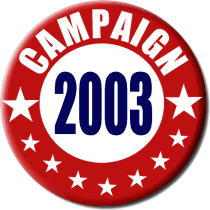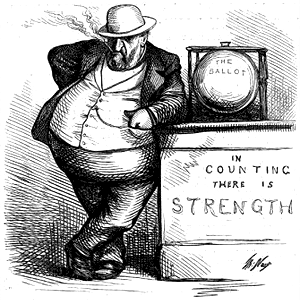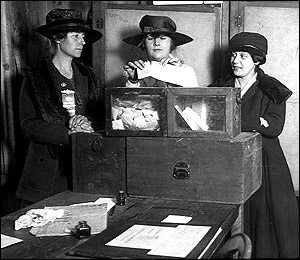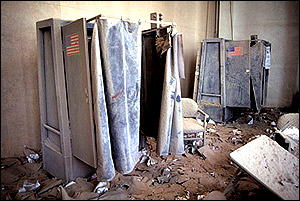Campaign 2003 - Primary Day: Guide to the Last Minute Voter
 Last Minute Voter's Guide: • Who Is On the Ballot? • Who Is Running in My District? • What Is At Stake? • Which Races Are Competitive? • Where Do I Vote? • Problems At the Polls? • How Do I Find Out Who Won? related links: • Complete Election Coverage • Primary Election Results • Find Your Polling Place related articles: • City Council Campaign 2003 • Ballot Bumping in New York • History of NY Election Law |
Since then, Ryneski has been trying to pay attention to his local City Council race - noting the campaign posters on street corners, reading the newspapers, and saving the Board of Election's postcard with the location of his polling place.
Still he admits that when it comes to issues - things like taxes, education, or housing - he has trouble telling the Democratic candidates apart. "I couldn't really tell if there is a difference between the three candidates [in Harlem]," said Ryneski.
Even for New York's most attentive voters, this year's City Council campaign has been difficult to follow.
There are no races for higher office to generate media attention and half of the 51 incumbent council members have no primary opponent. Even in the competitive races many incumbents have kept a low profile, skipping debates and public forums.
Still, the Primary Election on Tuesday - which will effectively decide 95 percent of City Council races given the overwhelmingly Democratic voters in New York - will have repercussions for the future of the city.
The 51 members of the City Council approve the city's budget and are responsible for tax increases and budget cuts. The council passes the laws governing the city. And council members make decisions that affect their individual neighborhoods - where housing is built, which community organizations are funded, and if a classroom gets computers.
For those voters looking for some help on Primary Day, we offer the following guide:
• Who Is On the Ballot?
• Who Is Running in My District?
• What Is At Stake?
• Which Races Are Competitive?
• Where Do I Vote?
• What If I Encounter Problems At the Polls?
• How Do I Find Out Who Won?
Who Is On The Ballot?
City Council: All 51 City Council members must run for reelection this year, but there are only 24 primary races on September 9. In the remaining districts, the incumbent is facing no challengers or all of the challengers were already knocked off the ballot.
In New York, which has some of the most complicated election laws in the nation, knocking your opponent off the ballot is a routine aspect of the political game. Dozens of candidates for City Council were eliminated on technicalities. And many more potential challengers did not even bother running, knowing that they would face huge legal bills and hours in court defending their right to run. (Read Ballot Bumping in New York for more these laws and why candidates were kicked off.)
All of the City Council primary races are for the Democratic party nomination, with the exception of district 5 on the Upper East Side which has a Republican primary.
Judicial Races: There are also a handful of judicial primary races for Civil Court: one in Manhattan, three in Brooklyn, and two in the Bronx. (See a list of candidates running for Civil Court Judge)
No Ballot Questions: There will NOT be any ballot questions on Primary Day, but Mayor Michael Bloomberg's Charter Commission will put several questions on the November 4 ballot, including one that would eliminate party primaries. In addition to nonpartisan elections, the commission will also put two other questions on the ballot dealing with the way the city buys goods and services, and the operations of city government. (For more information on nonpartisan elections, read It Is Time For Non-Partisan Elections In NYC by Frank J. Macchiarola and Instead of Non-Partisan Elections, Consider Some Real Reforms by Mark Green.)
Who Is Runnng In My District?
On Primary Day, some voters will find they live in a different City Council district than the last time they went to the polls.
Since the last local election in 2001, the City Council district lines were redrawn to reflect new census data, and so some voters have new representatives. Those who live on the edge of a district or in a neighborhood that has experienced a large change in ethnic make-up are most likely to see a change. (Read more about the City Council redistricting and the controversy it generated.)
The best way to find your district is to:
1. Go to Gotham Gazette's Campaign 2003 page.
2. Type in your address.
3. Click "Find It!"
4. Click on the Campaign Button in the top right hand column.
On the district page, you will find a list of candidates running, information about their campaign contributions, candidate biographies, and an archive of news stories from the campaign trail.
There is also information on how each council member voted on the dozen most divisive votes of the last two years - like the 18.5 percent property tax increase, the law that banned smoking in bars and restaurants, and a resolution urging the U.S. not to go to war with Iraq.
What Is At Stake?
While many New Yorkers may not be able to name their City Council member, most have something to say about issues like taxes, trash pick-ups, firehouse closures, or the school system, for which council members are responsible.
One of the City Council's primary responsibilities is approving the city's $44 billion budget. In the last two years, the City Council has approved increases to the property tax, sales tax, and income tax for the wealthiest New Yorkers. Just a few months ago, the council voted on a budget that cut 4,000 city workers and closed six firehouses. Next year, the city is expected to have a $2 billion deficit, which means that more cuts may be needed.
The council is responsible for passing laws that govern the city. This fall, the council is scheduled to consider legislation:
- Requiring gun owners to buy liability insurance
- Ensuring that the city notify residents if a homeless shelter will be built in the neighborhood
- Mandating weekly trash pick-ups
- Requiring landlords to clean up lead dust in apartments.
Council members also fight for funding for local community groups, little league teams, library improvements, and classroom computers.
Which Races Are Competitive?
The most watched race this year has been the campaign to fill the vacant seat of slain City Councilmember James Davis, who was shot in City Hall in July. Davis's brother, Geoffrey Davis, has been selected as the only Democratic nominee and there will be no primary for district 35. Four candidates will face off in the November general election.
But there are some primary races to watch.
In the north Bronx in district 12, Shirley Saunders, who lost to Larry Seabrook by just 103 votes in 2001, is running again and challenging the record of the incumbent. "I think people have seen Larry Seabrook more over the last three months [campaigning] than they have in all of sixteen years," said Saunders.
In district 18 Soundview and Parkchester, incumbent Councilmember Pedro Espada Jr. has dropped out of the race and handed his seat to his son Pedro G. Espada. He is facing a new challenger, Annabel Palma, who is backed by the Bronx Democratic Party.
In district 34 in Bushwick, Brooklyn, affordable housing has emerged as the number one issue in an area where the waterfront is being developed and trendy neighborhoods have pushed out long time residents. Incumbent City Councilmember Diana Reyna is facing a strong challenge from Juan Martinez, a former community school president.
In district 45, a nondescript building in East Flatbush could determine the political future of City Councilmember Kendall Stewart. He owns the building and blamed recent violations on his tenants. His challengers say he is not serving the community. "He is a slumlord," said one of his opponents.
For more races, read A Dozen Races To Watch.
Where Do I Vote?
Registered voters should have received a yellow post card in the mail with the address of their polling place. If you did not, call the Board of Elections at 1-866-VOTE NYC, try the board's poll site locator web site, or e-mail them at This email address is being protected from spambots. You need JavaScript enabled to view it. with your complete address, and you should receive an email instructing you where to vote.
Polls open at 6:00 a.m. and close at 9:00 p.m. Absentee ballots must be hand-delivered to the Board of Elections by 9:00 p.m.
What If I Encounter Problems At The Polls?
If you have problems at your polling site on Election Day, call the New York Public Interest Research Group Voter Help Line 212-822-0282 to register your complaint.
On their website, the New York Public Research Interest Group also has a instructions for how to work the voting machine and a Voter's Bill of Rights, which answers basic questions like "Can I bring someone with me to help vote?" and "Can I still vote if the machine breaks?" (The answer to both questions is "yes.")
How Do I Find Out Who Won?
Television stations and newspapers will cover the City Council races, but some results - like judicial races - are more difficult to find.
Visit Gotham Gazette's Results Page on election night and the following days. Remember, a close race can take days or weeks to decide.
A Brief History of Election Law in New York
 |
From Royal Rule to Public Finance
1665 - First Mayor
Governor Richard Nicolls appoints Thomas Willett the first "mayor of New York." For the next 156 years, the mayor will be appointed and have limited power.
1686 - Common Council
Governor Thomas Dongan divides New York City into six wards and creates a Common Council with an alderman and assistant alderman elected from each ward.
1820s - Property Qualifications Removed
In New York State, the right to vote is extended to all white males, regardless of whether they own or rent property.
1821 - Choosing a Mayor
The Common Council, which includes elected members, gains the authority to choose the mayor who will sit in City Hall. Previously, the state government appointed the mayor.
1834 - First Elected Mayor
An amendment to the state constitution provides for the direct popular election of the mayor. Cornelius W. Lawrence, a Democrat, is elected.
1846 - Voting Rights Rejected
New York voters reject a proposed amendment to the state constitution that would guarantee free blacks the same voting rights as whites.
1861 - Tammany Hall Emerges
Tammany Hall, which evolved from an organization of craftsmen into a Democratic political machine, gains control of Democratic Party nominations in the state and city.
1870 - Voting Rights
The 15th Amendment to the U.S. Constitution is ratified, giving blacks throughout the United States the same voting rights as whites.
1880 - Standard Ballot
In response to an era of political scandals, New York begins requiring the so-called "Australian ballot," a uniform ballot listing all candidates. To get on it, an office seeker would have to be nominated by a political party or submit nominating petitions, laying the groundwork for a system that persists to this day.
1890 - Primary Election
Because of perceived abuses in the way political parties select candidates, the New York State Legislature enacts a law that, for the first time, requires government to manage and pay for elections to select party officials who would then choose the party's candidates.
1892 - Voting Machine
The first voting machine, invented by Thomas Edison, is used in Lockport, New York in 1892. By the early 1920s, voting machines would be used for all general elections in New York City.
1894 - Bipartisan Control
The state establishes a system, in effect to this day, under which all election positions, from Board of Elections officials to poll watchers, must be divided equally between the two major parties.
 |
1898 - Greater New York Formed
A new City Charter merges Manhattan, the Bronx, Brooklyn, Queens and Staten Island into greater New York. All five boroughs now elect the mayor.
1915 - Suffragists Defeated
A referendum giving women the vote is defeated by city and state voters.
1920 - Suffragists Victorious
The 19th Amendment to the U.S. Constitution is signed into law, guaranteeing women throughout the United States the right to vote.
1965 - Opening the Polls
Congress passes the federal Voting Rights Act to ensure that no person is denied the right to vote on account of race or color.
1967 - A Black District
A suit brought under the Voting Rights Act leads to the creation of a majority black congressional district in Brooklyn. Previously, black voters had been divided among several predominantly white districts. In 1968, voters in the district elect Shirley Chisholm as the first black woman ever in the U.S. House of Representatives. Since then, congressional, state legislative and City Council districts have been drawn so as to ensure minority representation.
1969 - School Elections
Non-citizens who have children in public schools are given the right to vote in elections for members of community school boards.
1970 - Voting Rights in New York
The federal government determines that Manhattan, Brooklyn and the Bronx must be covered under the federal Voting Rights Act because of low voter registration levels. As a result, the federal government has to approve any changes in voting practices in these boroughs, including redistricting. This would mean that any switch to nonpartisan elections would require clearance by the U.S. Justice Department.
1971 - Younger Voters
The 26th Amendment lowers the voting age in New York from 21 to 18.
1975 - Multilingual Ballots and Election Information
Amendments to the Voting Rights Act require that election information be provided in Spanish as well as English in Brooklyn, the Bronx and Manhattan.
1988 - Ethical Finance
The Campaign Finance Board is formed as part of a response to corruption in city agencies. Its goal is to limit the influence of private funds in city politics. Candidates participating in the program can receive public money for their election campaigns. In return, they must agree to a spending limit and full disclosure of their campaign finances.
1989 - End of Board of Estimate
The U.S. Supreme Court abolishes the Board of Estimate, which gave each borough president an equal vote. The court rules that this violates the principle of one person-one vote because the boroughs vary so much in population. A new charter eliminates the board and distributes the board's powers between the mayor and an expanded City Council. 1992 - Chinese Ballots
The city begins providing voting information in Chinese, and Spanish is added to Queens ballots.
1993 - Term Limits
City voters approve a ballot measure, backed by millionaire Ronald Lauder, that would limit citywide officials, including the mayor, as well as borough presidents and members of the City Council to two consecutive four-year terms.
1996 - Public Debate
A law is passed requiring candidates who run for citywide office and participate in the Campaign Finance Program to participate in a series of public debates in order to receive public matching funds.
 Photograph by Steven McCurry |
1996 - Two Terms and You're Out
Voters reject a plan put forth by City Council Speaker Peter Vallone to delay the implementation of term limits and to allow officials three terms, instead of two.
2001 - Primary Date
The primary vote is originally scheduled for September 11. Voting begins that day but is halted after the attacks on the World Trade Center and postponed until September 25. With Primary Day always falling on the second Tuesday in September, some have urged the state to shift the election to keep it from ever falling on September 11. So far, such efforts have failed.
2001 - The Big Change
Because of term limits, all citywide officials and 37 of 51 City Council members are unable to run for reelection, creating the largest turnover in city history.
2003 - School Change
The state approves a law eliminating community school boards, replacing them with councils selected by parents.
2003 - Two More Years
The City Council adjusts the term limits law to allow some council members, who were elected in the middle of a term and would have had to leave office after serving fewer than eight years, to remain in their seats. The action cleared the way for Council Speaker Gifford Miller and four other members, who would have had to leave office in January, 2004, to seek re-election this November.




